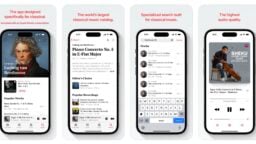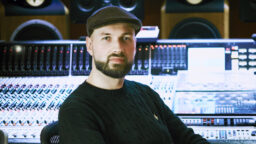Last month Apple Music announced that it was adding both Lossless Audio and Spatial Audio with support for Dolby Atmos, all bundled in free of charge with its $9.99-per-month streaming subscription.
Now, the two formats, which the company describes as “the next generation of sound” have been officially rolled out.
Spatial Audio delivers a surround sound experience to the listener, so that it sounds as if the different parts of the music are coming from all directions around you.
According to Apple, mixing a track in Spatial Audio lets artists create immersive audio experiences “with true multidimensional sound”.
“Thousands” of songs are already available in the format on the service, according to Apple, which adds that Spatial Audio albums will be identified with a badge on the detail page. They can also be found in new curated Spatial Audio playlists, which launch this week.
The music streaming service says that it’s working closely with artists and labels to add new Spatial Audio-compatible releases and catalog tracks.
In addition to its Spatial Audio roll out, Apple Music is making its catalog of more than 75 million songs available to subscribers in Lossless Audio.
Apple uses its own ALAC (Apple Lossless Audio Codec) and says that it’s entire catalog has now been encoded using ALAC in resolutions ranging from 16-bit/44.1 kHz (CD Quality) up to 24-bit/192 kHz.
What this means, according to Apple, is that listeners will be able to hear songs “exactly the way the artists created them in the studio”. Lossless Audio will consume significantly more data than lower-quality formats, however.
Marking the official launch of Apple Music’s Spatial Audio and Lossless Audio functions, Zane Lowe, Apple Music radio host and co-head of Artist Relations, claims in a blog post that Spatial Audio will “transform music”.
There is also a Zane Lowe-narrated Guide to Spatial Audio for listeners to compare the differences between Spatial Audio and other formats.
Apple is also doubling down on the format with plans to build music-authoring tools directly into its widely-used production software Logic Pro, and later this year will release a Logic Pro update that will allow musicians to create and mix songs in Spatial Audio.
The company also plans to double the number of Dolby-enabled studios in major markets, and to offer educational programs and resources for independent artists.
Spatial Audio is available to anyone with the latest iOS, iPadOS, and macOS updates. By default, Apple Music says that it will automatically play Spatial Audio with Dolby Atmos tracks on all AirPods and Beats headphones with an H1 or W1 chip, as well as the built-in speakers in the latest versions of iPhone, iPad, and Mac.
Third party headphones can be used to listen to the format by switching Dolby Atmos to always on in settings. Spatial Audio on Apple Music will also be coming soon to Android devices soon.
You can read Zane Lowe’s blog post in full below:
First there was mono, then stereo, and now there’s Spatial Audio. Spatial is an immersive experience with sound moving around you in different directions. We have only had that kind of experience before in cinema. Have you ever wondered how that would work with music? I have.
I first got the opportunity to listen to Spatial Audio on AirPods; I was confused at first. “Does this really work on AirPods? When do I get my car and go to some kind of listening room with special speakers?” And they were like, “No, no — just press play.”
Among the first songs I listened to were Lady Gaga’s “Rain on Me” and Kanye West’s “Black Skinhead.” It was hard to put into words because I’ve spent my whole life in a two-channel environment; I was born into stereo. It dawned on me that there are a lot of artists in the past and present who would have loved to be able to lean in with this kind of technology — to make their songs come to life, make them bigger, and just take them to levels no one had even thought of yet. But they only had two stereo channels to play with. Now they can go beyond that. So, to be able to hear parts of these songs coming from behind and around me? I was like, “I’m all in. I get it.” TV got HD — now music gets Spatial.
What I immediately thought was, “How are artists going to use this? How is Lil Baby going to use this? How are Olivia Rodrigo or Peggy Gou going to use this? How is Frank Ocean going to use this? Are they going to start creating music with the idea of a three-dimensional environment, as opposed to this two-channel environment?”
I’m fascinated to know how I might be emotionally moved by my favorite songs in a different way with Spatial Audio. Because it’s all going through my ears and triggering something, right? That’s what dawned on me when I was listening to these songs in Spatial: I was listening to these songs that I knew really well, but I was feeling something different. So, it’s not even just about the way it’s going to end up sounding, it’s very much how songs are going to feel.
I believe what is going to happen is that artists will start to hear things they haven’t heard before. Imagine Billy Corgan saying to the engineer, “When I created the guitar at the beginning of ‘Quiet’ in 1993 I wanted it to be heard from three-and-a-half miles behind you, and then I want it to land in front of your face in 3.2 seconds just as Jimmy Chamberlin’s drums begin.” Now, obviously, I’m not Billy Corgan and I just made that up. But if I can think about how it’s going to go, imagine what he’s going to do?
Music in modern times has often been all about innovation. From multichannel recordings, to electric guitars, mics, and synthesizers, to tape echo and samplers, to MIDI and iPod — so many technologies have been invented to play, capture, record, mix, and share music. With Spatial Audio musicians, engineers, and producers have this amazing new tool to bring a new 3D experience to millions of people. It all starts from one new tool for artists to experiment with and then eventually you end up with “Sgt. Pepper’s Lonely Hearts Club Band”; you end up with “Pet Sounds.”
It will come from the artists adopting it. It takes investment from the people who are going to use it and the people who are going to love it. When I started making beats when I was a kid, you had to save up a lot of money to get a sampler. They were not readily available and very few of them existed on the shelf. With Spatial Audio, I can put my AirPods in, press play, and have a Spatial experience; fans and artists have the means to listen to this and make music like this now. That’s when things change, because it can’t help but influence the young person who is sitting there listening going, “I want my music to sound that good.”
From here it’s going to be a really exciting journey. Eventually there will be new artists who are born into Spatial, just like I was born in stereo. Artists in the future might never even think about making a stereo record — because all they’ve ever known is Spatial. And making Spatial music is only going to get better. Apple is building immersive music-authoring tools directly into Logic Pro later this year. So any musician will be able to create and mix their songs in Spatial Audio for Apple Music — whether they’re in the studio, at home, or wherever.
Of course, stereo will always exist — no one is coming in and canceling stereo, just like they didn’t cancel mono. I’ve got a lot of mono records in my collection, and they sound great because they were designed to be heard in mono. Music that was designed to be heard in stereo will sound incredible in stereo like it always has. But now music will find its way to a Spatial environment. It’s not about the end of anything, it’s about the beginning of something new.
— Zane Lowe, Apple MusicMusic Business Worldwide




